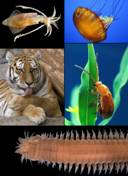Classify THIS!
Taxonomic Hierarchy
Above, the basic classification of the the Plains Snaggletooth is shown. Now, we can delve in deeper and explore each of the taxonomic levels that Gastrocopta abbreviata occupies. By doing so, we will receive a better understanding of the defining features that compose each taxonomic group as well as why Gastrocopta abbreviata has been classified in the above manner.
Organisms placed in this group possess the following characteristics:
 Kingdom Animalia--
multi-cellular, eukaryotic cells,
require oxygen to complete metabolic
functions, heterotrophic, capable of undergoing sexual reproduction,
mobility is common, capable of sensing and responding to its
environment (Russell, 2010).
Kingdom Animalia--
multi-cellular, eukaryotic cells,
require oxygen to complete metabolic
functions, heterotrophic, capable of undergoing sexual reproduction,
mobility is common, capable of sensing and responding to its
environment (Russell, 2010).
Phylum Mollusca-- bilateral symmetry, triploblastic, a mantle, a radula, an open circulatory system (with the exception of the cephalopods), eucoelomate, a complete digestive system, a muscular foot (Nash, 2004).
Class Gastropoda-- most possess a single, often coiled shell,
undergo torsion (180° twisting of the
visceral mass during development of the veliger), an
operculum, undergo process of coiling during visceral mass and shell
development (Gillis,
2011).
shell
development (Gillis,
2011).
Order Stylommatophora-- have a long pedal gland that lies beneath a membrane and retractile tentacles (Whittington et al. 2010).
Family Pupillidae-- a small to minute shell that is commonly pupa-shaped and an aperture that frequently contains several to multiple teeth (Burch, 1962).
Genus Gastrocopta-- angular lamellae converging inward that are more or less united with the parietal (Burch, 1962).
Species Gastrocopta abbreviata-- To view the attributes unique to this species, continue to Physical Characteristics.
Although the precise reasoning behind the naming of this species is unclear, I believe that both the scientific and common names can be directly applied to key characteristics of this snail. To begin, Gastrocopta means approximately "to cut/strike stomach." The word abbreviata, on the other hand, is a lot simpler to translate. This is an English cognate and means "to abbreviate or to make short" (Ayers, 1972). Therefore, the first word may be referring to a variation of things: feeding methods, the large denticles that characterize the aperture of the species' shell, etc. The other word in its name I believe coincides with its small stature which ranges from 3.3-4.2mm in length. The common name, Plains Snaggletooth, can also be broken down in order to gain its meaning. "Plains," I venture, correlates with the grassland plains that this species has the tendency to inhabit. "Snaggletooth" may coincide with the large denticles that are a characteristic feature within the aperture of this snail's shell.
Return to the homepage by clicking here.
